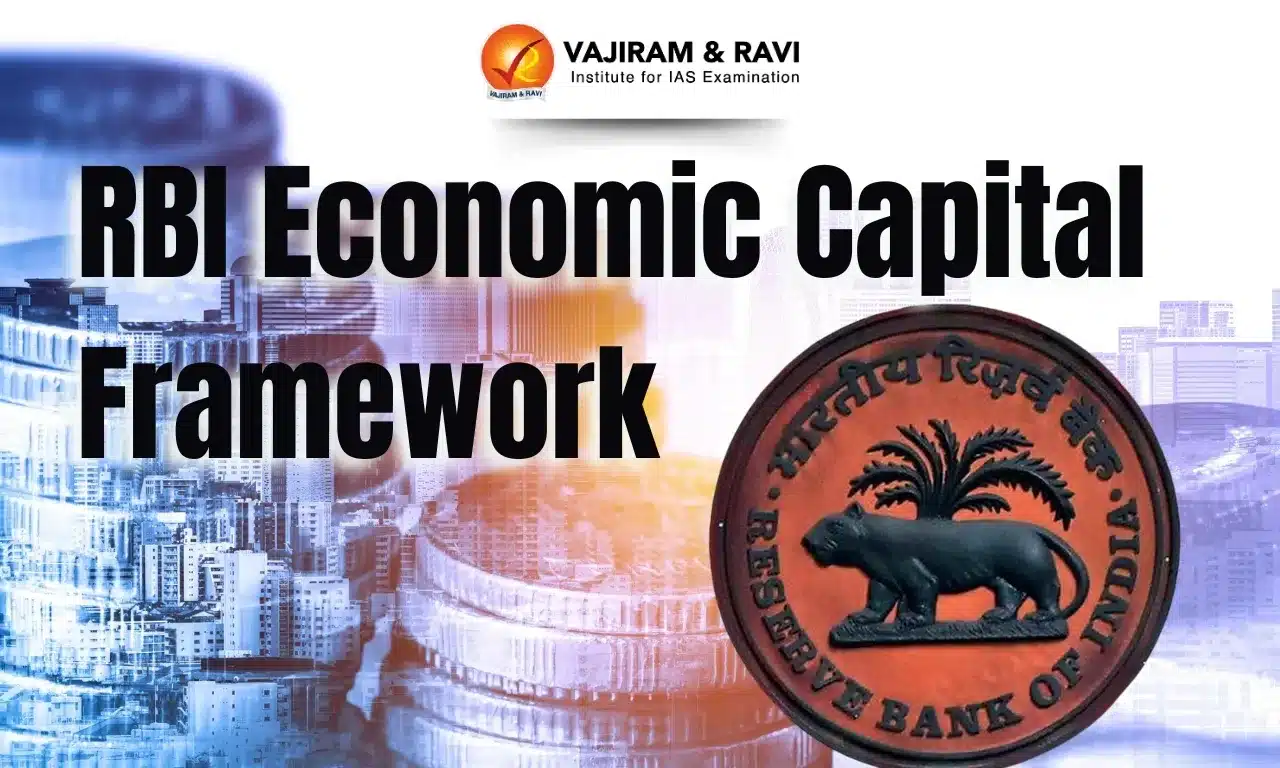What’s in Today’s article?
- RBI’s Economic Capital Framework Latest News
- Understanding the Economic Capital Framework (ECF)
- RBI’s Current Review of the ECF
- Impact of the ECF Review on RBI’s Surplus Transfers
- Importance of ECF Review
- Conclusion
- Economic Capital Framework FAQs
RBI’s Economic Capital Framework Latest News
- An internal committee of the Reserve Bank of India (RBI) is reviewing the entire economic capital framework (ECF) of the central bank.
Understanding the Economic Capital Framework (ECF)
- The Economic Capital Framework (ECF) is a policy that determines how the Reserve Bank of India (RBI) manages its financial reserves, risk provisioning, and surplus transfers to the central government.
- It sets guidelines for the contingency risk buffer (CRB)—a financial reserve maintained by the RBI to address unforeseen economic crises.
- The Bimal Jalan Committee, formed in 2018, recommended that the CRB should be maintained between 5.5% to 6.5% of the RBI’s balance sheet. This buffer acts as a safeguard for economic stability, ensuring that the RBI can function effectively as the Lender of Last Resort (LoLR) during financial crises.
- Since 2019, the RBI has followed these recommendations, and any revisions to the framework could influence how much surplus the RBI transfers to the government in future years.
RBI’s Current Review of the ECF
- RBI Governor’s Statement on ECF Review
- On Friday, RBI Governor Sanjay Malhotra confirmed that the central bank is reviewing the Economic Capital Framework.
- This periodic review, recommended by the Bimal Jalan Committee, is meant to assess whether any adjustments are needed in the CRB range.
- Malhotra clarified that while the current CRB stands at 6.5% (as of March 31, 2024), the review could lead to an increase or decrease in the required buffer, though no immediate changes have been confirmed.
- Background on the Bimal Jalan Committee Recommendations
- The Bimal Jalan-led panel had suggested a five-year review cycle for the ECF, with its recommendations valid from June 2019 to June 2024. Given this timeline, the RBI has now begun an internal assessment to evaluate whether changes are necessary.
- According to RBI Deputy Governor M. Rajeshwar Rao, the review will help determine if the current framework remains effective or if modifications are required to address evolving financial conditions.
Impact of the ECF Review on RBI’s Surplus Transfers
- Record Surplus Transfer to the Government in 2023-24
- For the financial year 2023-24, the RBI approved a record surplus transfer of ₹2.11 lakh crore to the central government.
- This amount significantly boosts government revenue and helps finance fiscal policies, including infrastructure projects and social welfare programs.
- How CRB Adjustments Could Affect Future Dividends
- Economists believe that any revision in the CRB threshold could directly impact future surplus transfers.
- If the CRB requirement is increased, the RBI may need to set aside more reserves, reducing the amount of surplus available for government transfers.
- Conversely, if the CRB is lowered, it could free up more funds for dividend payments.
- However, Governor Malhotra stated that the decision to revise the CRB is not linked to current global uncertainties, and any change will be based purely on economic factors rather than short-term concerns.
Importance of ECF Review
- Ensuring Economic Stability
- The contingency risk buffer serves as an essential financial safeguard against global financial instability, banking crises, and currency fluctuations.
- Maintaining an adequate buffer ensures that the RBI can respond effectively to any economic downturn.
- Impact on Government Budget Planning
- The RBI’s surplus transfers play a crucial role in supporting government spending and fiscal deficit management.
- Any change in the ECF could influence the government’s budgetary planning for the upcoming fiscal years.
- Balancing Risk and Development Needs
- The RBI must strike a balance between maintaining financial stability and providing surplus funds to the government.
- If the CRB is increased, it could strengthen the financial resilience of the central bank but may reduce funds available for government initiatives.
Conclusion
- The RBI’s review of the Economic Capital Framework is a crucial exercise that could determine the future allocation of financial reserves and surplus distribution.
- While the current contingency risk buffer (CRB) stands at 6.5%, the review will assess whether adjustments are needed to maintain economic resilience.
- A higher CRB could enhance financial security but reduce the RBI’s surplus transfers to the government, while a lower CRB could provide the government with more fiscal resources but may increase financial risks.
- As the five-year review process unfolds, all eyes will be on the RBI’s decision, which will have long-term implications for India’s economic and fiscal stability.
Economic Capital Framework FAQs
Q1. What is the Economic Capital Framework (ECF)?
Ans. The ECF is a policy that guides how the RBI manages financial reserves, risk provisioning, and surplus transfers to the government.
Q2. What is the contingency risk buffer (CRB) and why is it important?
Ans. The CRB is a financial reserve maintained by the RBI to handle economic crises and ensure financial stability.
Q3. What was the Bimal Jalan Committee’s recommendation on CRB?
Ans. The committee suggested maintaining the CRB between 5.5% to 6.5% of the RBI’s balance sheet for financial resilience.
Q4. How does the ECF review impact RBI’s surplus transfers to the government?
Ans. Any change in the CRB could increase or reduce the amount of surplus the RBI transfers to the government.
Q5. Why is the RBI reviewing the Economic Capital Framework now?
Ans. The review is part of a five-year periodic assessment recommended by the Bimal Jalan Committee, covering 2019-2024.
Last updated on June, 2025
→ UPSC Notification 2025 was released on 22nd January 2025.
→ UPSC Prelims Result 2025 is out now for the CSE held on 25 May 2025.
→ UPSC Prelims Question Paper 2025 and Unofficial Prelims Answer Key 2025 are available now.
→ UPSC Calendar 2026 is released on 15th May, 2025.
→ The UPSC Vacancy 2025 were released 1129, out of which 979 were for UPSC CSE and remaining 150 are for UPSC IFoS.
→ UPSC Mains 2025 will be conducted on 22nd August 2025.
→ UPSC Prelims 2026 will be conducted on 24th May, 2026 & UPSC Mains 2026 will be conducted on 21st August 2026.
→ The UPSC Selection Process is of 3 stages-Prelims, Mains and Interview.
→ UPSC Result 2024 is released with latest UPSC Marksheet 2024. Check Now!
→ UPSC Toppers List 2024 is released now. Shakti Dubey is UPSC AIR 1 2024 Topper.
→ Also check Best IAS Coaching in Delhi






















